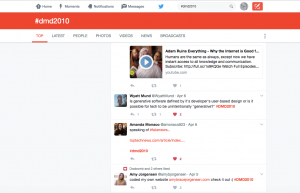By Marc Reyes

Articles about scholars using Twitter typically ask if you should bring the social networking platform into the classroom. The more appropriate question is how you should use Twitter in your course. If the last few years have taught us anything about the ever-changing social media landscape, it’s that Twitter is a force to be reckoned with, and it is not going away anytime soon. Its user-friendly platform, accessibility, and global reach should encourage all educators to consider Twitter a potential resource for their digital pedagogy.
As an educator, you’re always looking for ways to increase student participation. Last fall, my discussion sections for Digital Media and Design (DMD) 2010: History of Digital Culture had around twenty-four students. As stimulating as our conversations were with ten or twelve students speaking, I consistently strived for ways to bring the rest of our colleagues into the discussion. I wanted to reach the students more comfortable with a phone in their hand than raised in the air. So over the winter break, the course’s instructor, Professor Tom Scheinfeldt, and I decided to incorporate the use of Twitter as part of the students’ participation grade. It was a little shocking we had not considered it sooner. For a course chronicling the growth of digital culture, with examinations of the origins of social networking, a real-time use of social media to comment on course topics and bolster discussions made perfect sense. Furthermore, for those born around the dotcom bust and emergence of a more interactive Internet (Web 2.0), social media is a phenomenon my students (nearly all of whom are DMD majors) have known from an early age. Many, but not all, possess an ease navigating aspects of digital technology; they are arguably a “born digital” generation.
Students learned on day one what we expected from our course’s adoption of Twitter. By the end of the class’ first week, if they did not already have one, students needed to create a Twitter account and email their username to me. I collected them into a Google Doc and shared that information with each student–Tom and I wanted every user names shared so all the students could follow each other and comment on their colleagues’ tweets. Starting on week four, they had to post one tweet a week for a total of ten by semester’s end. Our guidelines for the tweets were this: whatever yo u post should link to themes discussed in the course and must include the hashtag #dmd2010. Using hashtags centralizes tweets into one easy to navigate location. We wanted fewer guidelines on what students could share, it is up to them and their creativity on what they post each week. Over the semester, students have posted news articles, podcast episodes, pictures, videos, gifs, and even their own contributions to digital culture. Other instructors submit weekly discussion questions or writing prompts and some request an original tweet from students as well as commenting on a classmates’ post. As enjoyable as it was to see what students shared, it is also exciting to see how students engage Twitter with a defined assignment or specific reading.
u post should link to themes discussed in the course and must include the hashtag #dmd2010. Using hashtags centralizes tweets into one easy to navigate location. We wanted fewer guidelines on what students could share, it is up to them and their creativity on what they post each week. Over the semester, students have posted news articles, podcast episodes, pictures, videos, gifs, and even their own contributions to digital culture. Other instructors submit weekly discussion questions or writing prompts and some request an original tweet from students as well as commenting on a classmates’ post. As enjoyable as it was to see what students shared, it is also exciting to see how students engage Twitter with a defined assignment or specific reading.

I made this discovery when our students read portions of Tristan Donovan’s Replay: The History of Video Games. In the past, students read select chapters and for discussion, I required they bring handwritten or typed open-ended questions meant to facilitate discussion. Instead this semester students submitted their queries via the #dmd2010 hashtag. Their questions, covering topics large and small, shaped the direction of the discussion. In addition to the probing questions posed, the supplementary material students found chronicling the early days of home video game consoles blew me away. They found nearly forty-year old Atari commercials, video demonstrations of the games we read about, and a recent interview with the founder of Atari that filled in biographical gaps the book did not cover. Some of these findings are so rich that Professor Scheinfeldt and I plan to include some of these sources in next semester’s syllabus.
I returned to soliciting student questions when we assigned the entirety of Jonathan Zittrain’s The Future of the Internet – And How to Stop It. A question of mine kicked off our discussion, but after that, their queries drove the conversation. By having their questions sent before class, I even screen-shot their questions and spliced some of them into my PowerPoint presentation. Questions were not saved until the end of the discussion, they could be dispensed throughout the presentation and I believe students have a greater connection to the conversation when they see their name and ideas incorporated into the instructor’s lesson plan. 
Twitter also can improve in-class exercises or group projects. Recently, our class held an Oxford-style debate where one side argued that social networking was good for society and the other side offered reasons against. I had each side have someone live-tweet their sides’ opening statement, rebuttal, and closing argument. The innovative students who took on this task had to listen closely and summarize lengthy statements into 140-character bursts.
I gave few guidelines because I wanted to see what these students could create. I was pleased as the live-tweeters produced photos, videos, and gifs documenting the proceedings and tagged their fellow students in their posts as they spoke or answered tough questions.
If you are interested in bringing Twitter into your classroom, I offer three suggestions:
- Set a good example for your students: tweet often and like and retweet what your students share. If they are tweeting once a week, try to tweet several times a week, everyday if possible. Vary what you tweet: one day share a news link, the next find a video or image worth passing around and explain its relationship to course themes. Also, comment on their tweets and go deeper into conversations than you normally would in the analog classroom. Consider Twitter as the digital classroom where time and space are relative, even if the numbers of characters are not.
- Do Twitter Show and Tell: carve out time for students to share what they tweet. Once or twice a week have students present, in front of their peers, what they tweeted. Either ask for volunteers or tell them to be prepared to share something next class. Also, encourage a student to present if one of their tweets related to a topic just discussed in class or that will be discussed soon. I am a fan of anything that has students working on their public speaking and building the confidence to teach to their peers.
- Follow hashtags, people, and teaching resources: for my discipline of history, #twitterstorians is a successful hashtag for asking questions, proposing new ideas, and connecting with scholars. Every Sunday, #ScholarSunday is trending with suggestions by scholars of whom to follow and how helpful their work has been to their colleagues. It is also a great way to highlight young and lesser-known scholars. It is open to all disciplines and encourages interdisciplinary collaboration. Professor Patrick Iber, a model user of academic Twitter, finds the platform useful in connecting people who share research interests and allows direct interaction between scholars in a variety of different academic environments. As for who to follow, start first with your friends and colleagues already on Twitter and then think of the people who inspire you and see if they have an account. I am surprised at the number of prominent scholars who have responded to something I wrote or to a question I posed. Historian Kevin Kruse suggested that scholars think of Twitter as their “global office hours: keep the door open and your mind too.” As for teaching resources, follow accounts like @insidehighered, @ProfHacker, and @teachprof. I also would be remiss if I failed to suggest that you follow @UConnGCCI to know what it is coming up on the “That Wasn’t on the Syllabus” blog.
Whether it is for strengthening discussions, enhancing assignments, or in-class activities, today’s teachers should incorporate Twitter for use in the classroom. Offer students some guidelines, but also urge them to make the most of the experience and flex their creative muscles when tweeting. Discussion must exist outside the classroom and in the digital realm, 140-characters can say a lot. Seeing what your students generate will convince you of its value and worthy place in your teaching repertoire. Check out the platform and see you in the Twitterverse!
Additional writing on the subject:
[1] http://www.processhistory.org/kruse-twitter/
[3] http://www.teachhub.com/50-ways-use-twitter-classroom
[4] https://globaldigitalcitizen.org/60-inspiring-examples-of-twitter-in-the-classroom
[5] https://www.timeshighereducation.com/comment/why-academics-should-make-time-for-social-media-app
[6] http://www.chronicle.com/blogs/profhacker/disposable-twitter-accounts-for-classroom-use/40145
[7] https://chroniclevitae.com/news/1021-rethinking-twitter-in-the-classroom